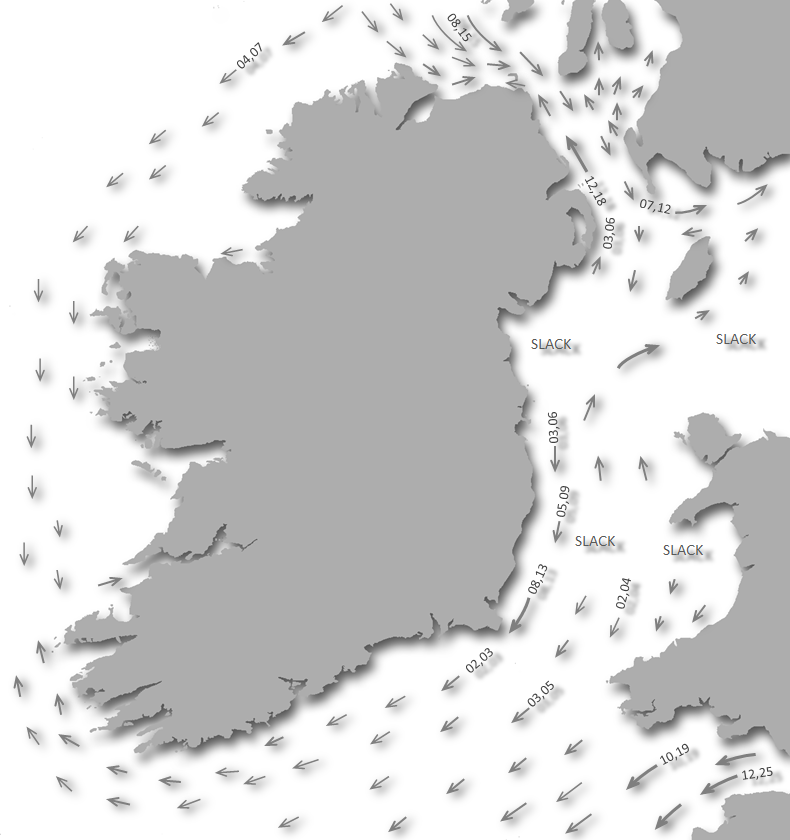
Set within an inlet at the head of a bay the anchorage offers good protection from all but strong southeasterly component winds where it would be subject to swell. Approaches to the general area are straightforward but the bay requires daylight access as there are some easily avoided but unmarked dangers in and around the bay.
Keyfacts for Carrigmore Bay
Facilities

Nature





Considerations
Protected sectors
Approaches


Shelter


Last modified
November 12th 2021 Summary
A tolerable location with attentive navigation required for access.Facilities

Nature





Considerations
Position and approaches
Expand to new tab or fullscreen
Haven position
 51° 30.739' N, 009° 39.390' W
51° 30.739' N, 009° 39.390' WThis is set in the middle of the inlet where 4 metres will be found.
What is the initial fix?
The following Toormore Bay initial fix will set up a final approach:
 51° 29.460' N, 009° 39.145' W
51° 29.460' N, 009° 39.145' W What are the key points of the approach?
Offshore details are available in southwestern Ireland’s Coastal Overview for Cork Harbour to Mizen Head  with seaward approaches available in the Crookhaven Harbour
with seaward approaches available in the Crookhaven Harbour  entry and local approaches can be found in the neighbouring Toormpore Cove
entry and local approaches can be found in the neighbouring Toormpore Cove  entry.
entry.
 with seaward approaches available in the Crookhaven Harbour
with seaward approaches available in the Crookhaven Harbour  entry and local approaches can be found in the neighbouring Toormpore Cove
entry and local approaches can be found in the neighbouring Toormpore Cove  entry.
entry.Not what you need?
Click the 'Next' and 'Previous' buttons to progress through neighbouring havens in a coastal 'clockwise' or 'anti-clockwise' sequence. Below are the ten nearest havens to Carrigmore Bay for your convenience.
Ten nearest havens by straight line charted distance and bearing:
- Toormore Cove - 0.4 nautical miles NE
- Dunmanus Harbour - 1.8 nautical miles N
- Goleen - 2.1 nautical miles WSW
- Croagh Bay - 2.8 nautical miles ESE
- Coney Island - 3.4 nautical miles E
- Colla Harbour - 3.6 nautical miles E
- Crookhaven - 3.7 nautical miles SW
- Long Island - 3.8 nautical miles E
- Kilcrohane Pier - 4 nautical miles NNW
- Dooneen Pier - 4.1 nautical miles NW
These havens are ordered by straight line charted distance and bearing, and can be reordered by compass direction or coastal sequence:
- Toormore Cove - 0.4 miles NE
- Dunmanus Harbour - 1.8 miles N
- Goleen - 2.1 miles WSW
- Croagh Bay - 2.8 miles ESE
- Coney Island - 3.4 miles E
- Colla Harbour - 3.6 miles E
- Crookhaven - 3.7 miles SW
- Long Island - 3.8 miles E
- Kilcrohane Pier - 4 miles NNW
- Dooneen Pier - 4.1 miles NW
Chart
What's the story here?
 Yacht anchored in Carrigmore Bay
Yacht anchored in Carrigmore BayImage: Michael Harpur
Toormore Bay opens 2½ miles to the northeast of the entrance to Crookhaven. The large bay nearly cuts halfway across the Mizen Head promontory, with the remaining isthmus between Dunmanus Harbour, opposite, and Toormore Bay being only 1½ miles across. At its head are the two small inlets of Toormore Cove, to the northeast, and Carrigmore Bay tucked in its northwestern corner. Carrigmore Bay is a large drying sandy inlet in a remote setting with an occasional neat bungalow beyond its beaches.
 Local boats moored off the beach in Carrigmore Bay
Local boats moored off the beach in Carrigmore BayImage: Burke Corbett
Sheltered by Reenard Point, the bay offers an anchorage with excellent sand holding in its entrance. After this, it becomes shallow and dries rapidly. Boats that can take to the bottom will find it possible to dry out in almost complete shelter behind the wooded point extending from the eastern side.
How to get in?
 Carrigmore Bay
Carrigmore BayImage: Michael Harpur
 Offshore details are available in southwestern Ireland’s Coastal Overview of Cork Harbour to Mizen Head
Offshore details are available in southwestern Ireland’s Coastal Overview of Cork Harbour to Mizen Head  for seaward approaches. Seward approaches are available in the Crookhaven Harbour
for seaward approaches. Seward approaches are available in the Crookhaven Harbour  and local approaches are available in the neighbouring Toormpore Cove
and local approaches are available in the neighbouring Toormpore Cove  as the entry to the anchorage lies close to Toormore’s approach path.
as the entry to the anchorage lies close to Toormore’s approach path. Carrigmore Bay with Castle Point, Dick's Island and Duharrig in the backdrop
Carrigmore Bay with Castle Point, Dick's Island and Duharrig in the backdropImage: Michael Harpur
From a central path up through Toormore Bay, turn to northwestern and enter Carrigmore Bay between Reenard and Coosgorm points. Carrigmore is clear up the centre from any known obstructions. Some local small boats and moorings will make the bay known.
 Carrigmore Bay as seen on approach
Carrigmore Bay as seen on approachImage: Burke Corbett
The bay shelves very quickly, about 250 metres within the outer entrance and dries from about abeam of the wooded point extending from the northeast.
 Carrigmore Bay and its western landing beaches
Carrigmore Bay and its western landing beachesImage: Michael Harpur
 Anchor according to draft in the outer bay outside a few local moorings. The sand provides excellent holding. Land on any of the beaches that surround the bay. Road access is only available on the western side.
Anchor according to draft in the outer bay outside a few local moorings. The sand provides excellent holding. Land on any of the beaches that surround the bay. Road access is only available on the western side.Why visit here?
Carrigmore Bay derives its name from the Irish 'An Charraig Mhór'. 'An' meaning 'the' 'carraig' meaning 'rock' and 'mór' meaning 'great' or 'big'; so the name means 'the great rock'. This name is a widely used placename in Ireland and in this case, it is thought to refer to the significant rocky outcrop that extends for a considerable distance along the eastern shoreline. This bluff, now capped by a grove of trees, serves to separate the outer and inner bays. The rocky outcrop that extends along the eastern shoreline
The rocky outcrop that extends along the eastern shorelineImage: Burke Corbett
Whatever the case Carrigmore Bay is a lovely sandy 'off the beaten track' anchorage where it is most likely that a visiting vessel will have the bay all to itself. Those who come here will find four excellent, secluded and protected beaches that make it an ideal destination for leisure vessels with young children hankering to get free to play and explore. Its gorgeous beaches are a mecca for younger children and with the anchored vessel standing between the sandy cove and Toormore Bay, it is also a very safe location to let older children loose in a tender or dinghy.
 The western beach with shore access
The western beach with shore accessImage: Burke Corbett
Two of its beaches are very much worth a mention and the first of these is the one on the west side of the inlet behind a broken line of large boulder rocks. This is the closest beach to the anchoring position and ideal for landing a shore party. Made up of white sand dotted with occasional large boulder rocks. Having road access, it is often used by a small number of locals for bathing.
_just_behind_the_forested_headland_.jpg) The eastern beach (right) just behind the forested headland
The eastern beach (right) just behind the forested headland Image: Michael Harpur
The second beach is further up the inlet, on the eastern shore behind the bay’s signature rocky headland. This is truly a spectacular sandy beach. Not only is it more protected than the landing beach. Because this has no convenient road access, those who land here, by tender, are most likely to have this vast sandy expanse all to themselves.
 Carrigmore Bay sequestered in rural West Cork
Carrigmore Bay sequestered in rural West CorkImage: Michael Harpur
From a boating perspective, Carrigmore Bay offers a delightful, beautiful and quiet setting, but it comes at the price of having no facilities. Toormore village is accessible by joining the road, on the west side of Carrigmore Bay, and then following it around the head of the bay and continuing eastward. This can be a bit of a hike and Toormore village is probably better accessed by lifting anchor and moving just a little over a quarter of a mile and anchoring in Toormore Cove itself.
What facilities are available?
There are no facilities at this remote anchorage.Any security concerns?
Never an issue known to have occurred to vessel anchored in Carrigmore.With thanks to:
Burke Corbett, Gusserane, New Ross, Co. Wexford.Add your review or comment:
Please log in to leave a review of this haven.
Please note eOceanic makes no guarantee of the validity of this information, we have not visited this haven and do not have first-hand experience to qualify the data. Although the contributors are vetted by peer review as practised authorities, they are in no way, whatsoever, responsible for the accuracy of their contributions. It is essential that you thoroughly check the accuracy and suitability for your vessel of any waypoints offered in any context plus the precision of your GPS. Any data provided on this page is entirely used at your own risk and you must read our legal page if you view data on this site. Free to use sea charts courtesy of Navionics.












